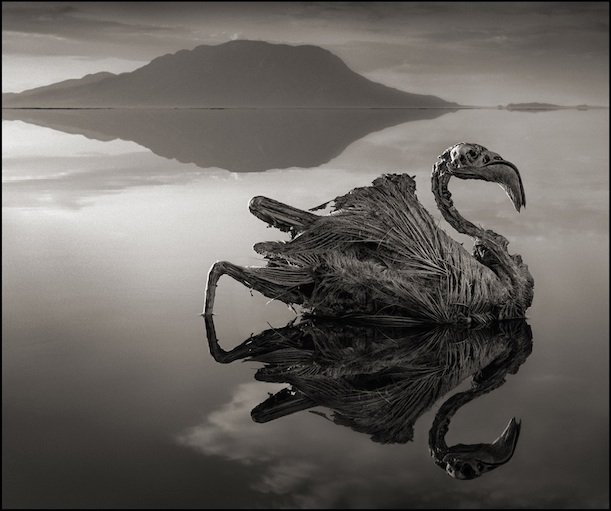In 2011, when he was traveling to shoot photos for a new book on the disappearing wildlife of East Africa, Across the Ravaged Land, photographer Nick Brandt came across a truly astounding place: A natural lake that seemingly turns all sorts of animals into stone.

“When I saw those creatures for the first time alongside the lake, I was completely blown away,” says Brandt. “The idea for me, instantly, was to take portraits of them as if they were alive.”
The ghastly Lake Natron, in northern Tanzania, is a salt lake—meaning that water flows in, but doesn’t flow out, so it can only escape by evaporation. Over time, as water evaporates, it leaves behind high concentrations of salt and other minerals, like at the Dead Sea and Utah’s Great Salt Lake.
Unlike those other lakes, though, Lake Natron is extremely alkaline, due to high amounts of the chemical natron (a mix of sodium carbonate and baking soda) in the water. The water’s pH has been measured as high as 10.5—nearly as high as ammonia. “It’s so high that it would strip the ink off my Kodak film boxes within a few seconds,” Brandt says.

As you might expect, few creatures live in the harsh waters, which can reach 140 degrees Fahreinheit—they’re home to just a single fish species (Alcolapia latilabris), some algae and a colony of flamingos that feeds on the algae and breeds on the shore.
Frequently, though, migrating birds crash into the lake’s surface. Brandt theorizes that the highly-reflective, chemical dense waters act like a glass door, fooling birds into thinking they’re flying through empty space (not long ago, a helicopter pilot tragically fell victim to the same illusion, and his crashed aircraft was rapidly corroded by the lake’s waters). During dry season, Brandt discovered, when the water recedes, the birds’ desiccated, chemically-preserved carcasses wash up along the coastline.
Read more: http://blogs.smithsonianmag.com/artscience/2013/10/this-alkaline-african-lake-turns-animals-into-stone